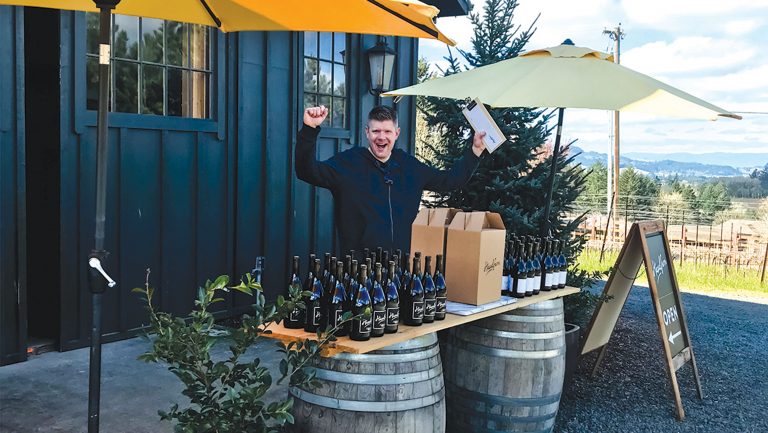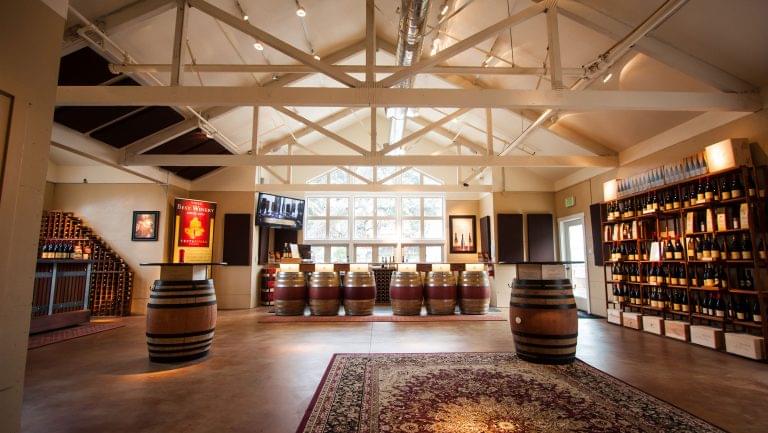When word came on March 17 that California’s tasting rooms must shutter, Dan Panella, co-owner and winemaker at Oak Farm Vineyards in Lodi, California, considered his numbers. Sixty percent of his 30,000-case business was through wholesalers, but as restaurants closed, that melted by half. Nearly all his direct-to-consumer (DTC) sales had been in his tasting room. Online amounted to a fraction of revenue.
Panella reacted quickly. For cars still bumping up his driveway, he sold wine to-go. He emailed his entire mailing list—4,000 strong, including 2,500 wine club members—and offered free shipping on orders of three wines or more. His efforts paid off, and his online sales shot up.
He also tightened the belt. Part-time workers, about half of his 22-person team, received two weeks paid leave, and would then apply for unemployment. “We expect to hire them back when this is over,” Panella says, which he doesn’t think will happen anytime soon. He predicts the shelter-in-place restrictions to last a while, so he’s considering cutting future costs by holding back bottling and rethinking grower contracts.

Don’t miss the latest drinks industry news and insights. Sign up for our award-winning newsletters and get insider intel, resources, and trends delivered to your inbox every week.
Pain Everywhere
Winemakers across the nation are facing the same harsh realities as Panella. A WineAmerica survey completed by 10 percent of the industry in the third week of March showed nearly 4,500 layoffs and a $40.4 million loss. If we take the respondents as representative, says WineAmerica, U.S. wineries got clobbered for a total estimated $400 million last month. The pandemic hit just as the spring release season was rolling in with pick-up parties, festivals, and winemakers’ scheduled visits to restaurants and retailers. All that evaporated.
Napa Valley came into the crisis already bruised. With China retaliating in-kind against the Trump Administration’s tariffs, total U.S. wine sales to China fell from a high of $81.5 million in 2016 down to $39 million in 2019. Responsible for 95 percent of all U.S. wine exports, Napa was hardest hit. California wine altogether had been experiencing a slump—perhaps a corrective to overproduction and overpricing, but often blamed on millennials’ refusal to drink enough wine.
In other states with smaller, lesser known wineries, business is tourism-first, and the shutdowns hit like a hammer. “Right now, we would be gearing up for our busy time in tasting rooms. Often sales are put back into production as we head into growing season and bottling,” says George Hodson, president of Virginia’s Monticello Wine Trail. “Not having the income is causing wineries to make tough operational decisions.”
Though Washington state is home to some large commercial brands with grocery store distribution, like Columbia Crest, more than 96 percent of its wineries are small and reliant on other avenues for sales. Half of the 2,500 cases produced at the Yakima Valley’s Côte Bonneville went to restaurants. The rest of the sales were DTC, split evenly between their tasting room and online. That has left the family business with a potential three-quarters loss in sales. Like many, winemaker Kerry Shiels is counting on financial relief through the CARES Act, but the legislation leaves her with a lot of questions: “The challenge is, what are you eligible for? Paycheck protection, grants, loan deferrals… if you go down one avenue, are you excluded from the others? We’re trying to figure out how to navigate the process.”
Oregonians are especially gloomy. “What’s so sad is that, at the beginning of the year, Oregon was the bright spot in the industry. We were overperforming in DTC,” says Morgen McLaughlin, executive director of the Willamette Valley Wineries Association. Many of those sales face-to-face, the result of the association’s marketing push to get consumers on the Oregon wine trail. “Traditionally, our tasting room visits were among the lowest in the nation,” she says. With the campaign, the numbers were starting to change for the better. “But that’s gone away overnight.”
Small Producers Suffering
What’s happening in Oregon is a microcosm of distress nationwide. Willamette Valley Pinot Noir, the state’s pricey flagship wine, relied largely on restaurant sales—a channel that has dried up. That’s left both wineries and small distributors struggling. “For big [wholesalers], on-premise is less important, but for wholesalers like us, restaurants represent up to 80 percent of business,” says Merritt Olson of Oregon’s Mitchell Wine Group, a fine wine distributor.
Victor Martinez, owner of Ardor, a natural wine shop in Portland, Oregon, sees a massive domino effect: “It’s all a trickle down, from the consumer to me, me to the distributors, the distributors to the winemakers, and the [growers]. They have to farm; fruit’s coming. Is anyone going to buy it?”
If Sam Baron, winemaker at Sonoma’s Kivelstadt Cellars, is any indication, farmers could be looking at lower margins than expected. “We cancelled future bottlings. I called my growers and said, ‘We’re not going to do right by you at the expense of going under. So we want to work with you to figure it out.’ We can’t just [buy] fruit if we have a whole back vintage to sell. We don’t have the money to float it.”
Kivelstadt’s position illustrates the divide between big and boutique wineries. “Restaurants are the marketing platform for every small winery that doesn’t have a marketing team,” says Baron. He makes just 4,000 cases. “When restaurants close down, there’s wine being sold, but it’s bigger, cheaper [brands].”
With its larger case count, wider price spread, and reach into higher-end grocers like Whole Foods, Oak Farm Vineyards might see some of that revenue. “The assumption is that this is a recession, and people won’t consume as much wine,” says Panella. “But 2008 to 2010, people did buy wine, just less expensive, so there are opportunities for our less expensive programs.”
There are some wineries that might be too small to fail. Megan Bell makes 1,000 cases at Margins Wine, a one-woman operation on California’s Central Coast. Like a lot of startup winemakers, she earns her income elsewhere, supporting herself on odd jobs supplemented by food stamps. Though 2020 was the year she was going to start paying herself $300 a month from wine sales—a move postponed by the crisis—Bell says, “In some ways, I feel better prepared for this because I’m used to living on no money. It’s like my super power.”
Leaning In to DTC
Beyond wholesale, marquee brands have the marketing power to nurture substantial wine clubs and digital sales. According to Sovos’s Direct-to-Consumer Wine Shipping Report, 6.6 million cases of wine were shipped DTC in 2019, valued at $3.2 billion. Wine clubs are a driver, and the bigger the winery, the more important its club. At 1,000 cases or less, clubs bring a quarter of DTC sales on average, while in half-million-case operations, wine clubs amount to 46 percent of DTC. Napa is the long-distance champ, says WineDirect, with 81 percent of its DTC sales happening outside of tasting rooms. And because there’s no middleman taking a cut, bottle for bottle, DTC is where the money is.

With efforts to reach consumers stuck at home, producers are seeing radical spikes in wine club sales. Napa’s Far Niente has a wine club 10,000 members strong, representing half its revenue. No wonder chief executive officer Steve Spadarotto says, “As I view tasting rooms, they exist only to sign up new club members and entertain current ones.” The winery, which is part of a five-brand, 125,000-case company, has been successfully wooing its members with special offers, free shipping, and curbside pickup to grow their DTC sales double digits since last year at this time.
Those that can afford to contract with a firm like the telemarketing company VinoPro can capture historical DTC sales now. VinoPro founder Jeff Stevenson says his staff telephones the mailing lists of winery clients like Napa’s Trinitas Cellars and Sonoma’s Iron Horse. Right now, combined calls for all his clients are resulting in $60,000 record sales days. “People love getting these phone calls,” Stevenson reports. “We get them to stop watching the news for half an hour and have a conversation about their favorite topic, which is drinking wine.”
Given established wine clubs with active members who are sharing deals and discounts with friends, even smaller wineries are seeing a marked uptick in online sales. Côte Bonneville’s Shiels reports a 300-percent increase in orders shipped to consumers’ homes.
It’s a different scenario for wineries with no established DTC pipeline, such as Maloof Wines in Dundee, Oregon, where husband and wife team Ross and Bee Maloof sold their 2,100 case production primarily to restaurants through distributors. “We have no tasting room… and we’ve never sent a single email,” says Ross Maloof. “Now there’s no way the wine is going to disappear as fast as it has. Maybe this month will be the first email we send.”

Telling a Stronger Virtual Story
If Maloof does send out an email, another young Oregon producer, Hazelfern Cellars’s owner and winemaker Bryan Laing, has advice for him: “Double-down on content creation and storytelling.” At his 3,000-case winery, “it’s all experiences and coming to the winery,” says Laing. “We had to reinvent the business.” Laing and his wife Laura rebranded their family Chevrolet Suburban as “the wine truck,” taking advantage of a little-known Oregon same-day delivery permit. They hit different neighborhoods, putting out word on social media via Instagram Stories, where they’ve also been posting virtual happy hours and “pantry quarantine” recipes. “People are stuck at home on their phones looking for entertainment and updates from their favorite brands,” says Laing.
Across the country, wineries are more actively reaching out. “We’ve been on the phone all week, and most people we call are looking to stock up,” says Gabriella Macari of Long Island, New York’s Macari Vineyards. She’s converted tasting room staff to “digital ambassadors.” Using dedicated discount codes to promote Macari wines on social media, they earn commission on sales.
Mendocino, California’s Testa Vineyards is running trivia contests via Instagram Stories, with discount codes for correct answers. In Sonoma, Balletto Vineyards is shipping wines for Facebook Live brunches with the Balletto family, and they’ve teamed up with a local shop for online wine and cheese pairings. Scores of wineries are offering virtual tastings, including big names like Frog’s Leap and Virginia’s historic Barboursville Vineyards, with winemakers leading participants through bottles they’re encouraged to purchase beforehand. Aperture Cellars in Healdsburg, California is launching a new tasting room with virtual tours via Instagram Live.
To sell locally, wineries with kitchens or restaurant partners are offering curbside or drop-off pairing dinners. At Page Springs Cellars in Cornville, Arizona—where the (now closed) tasting room is responsible for over 80 percent of sales—owner and winemaker Eric Glomski is partnering with Farm-A-GoGo to deliver wine alongside prepared meals and local eggs, olive oils, and jellies. Fans of Friday happy hours at Mendocino’s RIVINO can pick up meals and bottles at the winery and enjoy them at home to a live stream of musical acts. Other wineries are appealing to consumers by helping those in need. Sonoma’s MacRostie Winery donates $10 from each online order to No Kid Hungry, and Cuvaison Winery is giving $5 from every May club shipment to the Restaurant Workers’ Community Foundation.
Free shipping and home delivery have become mainstays. Winery associations and local bloggers feature running lists of the winery deals in their area. “Yep, this is different and hard,” says Mary Jo Dale of the marketing consultancy Customer Vineyard. “But it’s also an incredible opportunity if you’re willing to rethink the model, pivot, and try some stuff.”
A Permanently Changed Landscape
State DTC laws are still a morass; wineries must follow 50 different sets of shipping regulations. “There are so many ridiculous regulations around alcohol,” says Meaghan Frank of the New York Finger Lakes’s Dr. Konstantin Frank Winery. “I hope when we come out of this that some of those are relaxed forever. That would be a bright spot from this.”

Hazelfern’s Bryan Laing also predicts lasting change: “The way people get their wine is going to change even after the pandemic because all these new models are popping up. Wineries are doing deliveries, and there’s no reason to stop when this is over.”
Others worry that, despite the adaptations, wineries can’t withstand the collapse of the hospitality industry upon which they rely. With many restaurants and inns unable to recover from the closures, “infrastructure may look really different,” says McLaughlin. Wine regions are successful, she believes, only when “small, local businesses survive.”
Page Springs Cellars’ Glomski fears that many small wineries and restaurants, in spite of efforts to evolve quickly, are “business models not suited to the current market.” There will be “Darwinian” fallout, he worries: “It’s sad because most of the big guys will survive and the cool, little, detailed expressions of humanity and culture will suffer and many will disappear.”
Just how many of the nation’s blossoming wine regions will weather this storm? “If it’s a two-month problem, fine. But if it takes the rest of the year to pull out of this, that’s a different question,” says Spadarotto, “and it’s the not-knowing that’s so difficult to deal with.”
In the meantime, as essential businesses, wineries can still make wine. And in a world of uncertainty, the work of tending to an evolving product and coaxing it toward beauty remains a constant. “We’re trying to be helpful in social distancing, so maybe once a week we go down to the winery and check on things, one of us at a time,” says Ross Maloof. “The other day, I got to taste through the cellar on my own. The wines are tasting great, and they are oblivious to this whole thing. So it was a moment of solace.”

Dispatch
Sign up for our award-winning newsletter
Don’t miss the latest drinks industry news and insights—delivered to your inbox every week.
Betsy Andrews is an award-winning journalist and poet. Her latest book is Crowded. Her writing can be found at betsyandrews.contently.com.






